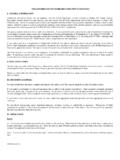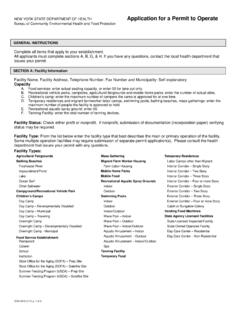Transcription of Naphthalene
1 Naphthalene91-20-3 Hazard SummaryNaphthalene is used in the production of phthalic anhydride; it is also used in mothballs. Acute (short-term) exposure of humans to Naphthalene by inhalation, ingestion, and dermal contact is associated withhemolytic anemia, damage to the liver, and neurological damage. Cataracts have also been reported inworkers acutely exposed to Naphthalene by inhalation and ingestion. Chronic (long-term) exposure ofworkers and rodents to Naphthalene has been reported to cause cataracts and damage to the retina. Hemolytic anemia has been reported in infants born to mothers who "sniffed" and ingested Naphthalene (asmothballs) during pregnancy. Available data are inadequate to establish a causal relationship betweenexposure to Naphthalene and cancer in humans. EPA has classified Naphthalene as a Group C, possiblehuman Note: The main sources of information for this fact sheet are the EPA's Toxicological Review of Naphthalene (7) and the Agency for Toxic Substances and Disease Registry's (ATSDR's) Toxicological Profile for Naphthalene .
2 (1)UsesThe primary use for Naphthalene is in the production of phthalic anhydride. However, o-xylene is replacing Naphthalene as the preferred raw material for phthalic anhydride production. (1)Other uses of Naphthalene include carbamate insecticides, surface active agents and resins, as a dye intermediate, as a synthetic tanning agent, as a moth repellent, and in miscellaneous organic chemicals.(1,2)Sources and Potential ExposureIndividuals may be exposed to Naphthalene through the use of mothballs. (1)Workers may be occupationally exposed to Naphthalene during its manufacture and use, especially in coal-tar production, wood preserving, tanning , or ink and dye production. (1) Naphthalene is released to the air from the burning of coal and oil and from the use of mothballs. Coal tar production, wood preserving, and other industries release small amounts. (1)Typical air concentrations of Naphthalene in cities are about parts per billion (ppb).
3 (1) Naphthalene has also been detected in tobacco smoke. (1)Assessing Personal ExposureNaphthalene or its breakdown products can be measured in fat, urine, and feces. These tests cannot be used to find out how much exposure occurred and require special equipment not routinely available in a doctor's office. (1)Health Hazard InformationAcute Effects:Acute exposure of humans to Naphthalene by inhalation, ingestion, and dermal contact is associated withAcute exposure of humans to Naphthalene by inhalation, ingestion, and dermal contact is associated with hemolytic anemia, damage to the liver, and, in infants, neurological damage. Symptoms of acute exposure include headache, nausea, vomiting, diarrhea, malaise, confusion, anemia, jaundice, convulsions, and coma. (1,2,6,7)Cataracts have been reported in humans acutely exposed to Naphthalene by inhalation and ingestion. Cataracts have also been reported in animals following acute oral exposure.
4 (6,7,9)Tests involving acute exposure of rats, mice, rabbits, and guinea pigs have demonstrated Naphthalene to have moderate to high acute toxicity from ingestion and low to moderate acute toxicity from dermal exposure. (3)Chronic Effects (Noncancer):Chronic exposure of workers to Naphthalene has been reported to cause cataracts and retinal hemorrhage.(2,4,5,6,7)Chronic inflammation of the lung, chronic nasal inflammation, hyperplasia of the respiratory epithelium in the nose, and metaplasia of the olfactory epithelium were reported in mice chronically exposed to Naphthalene via inhalation. (1,6,7)Rats, rabbits, and mice chronically exposed to Naphthalene via ingestion have developed cataracts and degeneration of the retina. (2,5,6,7)Diarrhea, lethargy, hunched posture, rough coats, decreased body weight, and lesions in the kidneys and thymus were observed in rats and mice chronically exposed via gavage (experimentally placing the chemical in the stomach).
5 (2,6,7)EPA has calculated a Reference Concentration (RfC) of milligrams per cubic meter (mg/m3) for Naphthalene based on nasal effects in mice. The RfC is an estimate (with uncertainty spanning perhaps an order of magnitude) of a continuous inhalation exposure to the human population (including sensitive subgroups) that is likely to be without appreciable risk of deleterious noncancer effects during a lifetime. It is not a direct estimator of risk but rather a reference point to gauge the potential effects. At exposures increasingly greater than the RfC, the potential for adverse health effects increases. Lifetime exposure above the RfC does not imply that an adverse health effect would necessarily occur. (6,7)EPA has medium confidence in the RfC based on: 1) medium confidence in the principal study because adequate numbers of animals were used , severity of nasal effects increased at higher exposure concentrations, high mortality, and hematological evaluation not conducted beyond 14 days; and 2) low to medium confidence in the database because there are no chronic or subchronic inhalation studies in other animal species and there are no reproductive or developmental inhalation studies.
6 (6,7)The Reference Dose (RfD) for Naphthalene is milligrams per kilogram body weight per day (mg/kg/d) based on decreased body weight in male rats. (6,7)EPA has low confidence in the RfD based on: 1) high confidence in the principal study because adequate numbers of animals were included and experimental protocols were adequately designed, conducted, and reported; and 2) low confidence in the database because of the lack of adequate chronic oral data, dose-response data for hemolytic anemia, and two-generation reproductive toxicological studies. (6,7)Reproductive/Developmental Effects:Hemolytic anemia has been reported in infants born to mothers who "sniffed" and ingested Naphthalene (as mothballs) during pregnancy. The mothers themselves were anemic, but to a lesser extent than the infants. (5,6,7)Signs of maternal toxicity ( , decreased body weight and lethargy) but no fetal effects were reported in rats and rabbits exposed to Naphthalene via gavage.
7 (6,7)Maternal toxicity (increased mortality and reduced weight gain) and fetotoxicity (reduced number of live pups per litter) were observed in mice exposed via gavage. (2,6,7)Cancer Risk:Workers occupationally exposed to vapors of Naphthalene and coal tar developed laryngeal carcinomas orWorkers occupationally exposed to vapors of Naphthalene and coal tar developed laryngeal carcinomas or neoplasms of the pylorus and cecum. However, this study is inadequate because there were no controls, exposure levels were not determined, and subjects were exposed to complex mixtures containing other demonstrated carcinogens. (2,5,6,7)Di-, tri-, and tetramethyl Naphthalene contaminants of coal tar were found to be carcinogenic when applied to the skin of mice, but Naphthalene alone was not. (2,5)An increased number of alveolar/bronchiolar adenomas and carcinomas were reported in female mice exposed by inhalation. (1,6,7)No carcinogenic responses were reported in rats exposed to Naphthalene in their diet and by injection.
8 (2,5,6)EPA has classified Naphthalene as a Group C, possible human carcinogen. (6,7)Physical PropertiesThe chemical formula for Naphthalene is C10H8 , and its molecular weight is g/mol. (1) Naphthalene occurs as a white solid or powder that is insoluble in water. (1,8) Naphthalene has a strong, mothball odor, with an odor threshold of mg/m3 ( parts per million, ppm). (1,9)The vapor pressure for Naphthalene is mm Hg at 25 C, and its log octanol/water partition coefficient (log Kow) is (1)Conversion Factors: To convert concentrations in air (at 25 C) from ppm to mg/m3: mg/m3 = (ppm) (molecular weight of thecompound)/( ). For Naphthalene : 1 ppm = Data from Inhalation ExposureACGIH TLV--American Conference of Governmental and Industrial Hygienists' threshold limit value expressed as atime-weighted average; the concentration of a substance to which most workers can be exposed without adverseeffects. ACGIH STEL--American Conference of Governmental and Industrial Hygienists' threshold limit value short-termexposure limit; a 15-minute TWA exposure which should not be exceeded at any time during a workday.
9 LOAEL--Lowest observed adverse effect level. NIOSH REL--National Institute of Occupational Safety and Health's recommended exposure limit; NIOSH-recommended exposure limit for an 8- or 10-h time-weighted-average exposure and/or ceiling. NIOSH IDLH -- NIOSH's immediately dangerous to life or health concentration; NIOSH recommended exposure limitto ensure that a worker can escape from an exposure condition that is likely to cause death or immediate ordelayed permanent adverse health effects or prevent escape from the environment. NIOSH STEL--NIOSH's recommended short-term exposure limit; a 15-minute TWA exposure which should not beexceeded at any time during a workday. OSHA PEL--Occupational Safety and Health Administration's permissible exposure limit expressed as a time-weighted average; the concentration of a substance to which most workers can be exposed without adverse effectaveraged over a normal 8-h workday or a 40-h health and regulatory values cited in this factsheet were obtained in December Health numbers are toxicological numbers from animal testing or risk assessment values developed by EPA.
10 B Regulatory numbers are values that have been incorporated in Government regulations, while advisory numbersare nonregulatory values provided by the Government or other groups as advice. OSHA numbers are regulatory,whereas NIOSH and ACGIH numbers are This LOAEL is from the critical study used as the basis for the EPA Agency for Toxic Substances and Disease Registry (ATSDR). Toxicological Profile for Naphthalene (Update).Public Health Service, Department of Health and Human Services, Atlanta, GA. Environmental Protection Agency. Health and Environmental Effects Profile for Environmental Criteria and Assessment Office, Office of Health and EnvironmentalAssessment, Office of Research and Development, Cincinnati, OH. Department of Health and Human Services. Registry of Toxic Effects of Chemical Substances (RTECS,online database). National Toxicology Information Program, National Library of Medicine, Bethesda, Department of Health and Human Services.
















